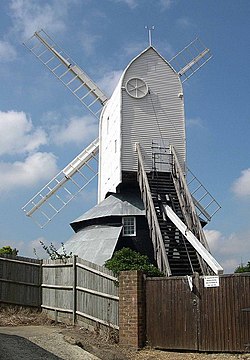Windmill Hill Mill, Herstmonceux
| Windmill Hill Mill, Herstmonceux | |
|---|---|

The mill in 2006
|
|
| Origin | |
| Mill location | TQ 648 122, 50°53′10″N 0°20′31″E / 50.886°N 0.342°E |
| Year built | ca. 1814 |
| Information | |
| Purpose | Corn mill |
| Type | Post mill |
| Roundhouse storeys | Two storey roundhouse |
| No. of sails | Four |
| Type of sails | Patent sails |
| Windshaft | Cast iron |
| Winding | Originally Tailpole, now by computer controlled battery powered electric motor |
| No. of pairs of millstones | Two pairs, arranged Head and Tail |
| Other information | Largest post mill in Sussex. Only surviving example of Hammond's Patent Sweep Governor is fitted to this mill. |
Windmill Hill Mill is a grade II* listedpost mill at Herstmonceux, Sussex, England which has been restored and now operates as a working mill.
Windmill Hill Mill was built c. 1814 by Samuel Medhurst, the Lewes millwright. It was working by wind until 1893, when it was stopped owing to a weak weatherbeam. It is the largest post mill in Sussex, and is unique in that it is fitted with Hammond's Patent Sweep Governor, a feature previously fitted to Jack Mill, Clayton.
After work by wind had ceased, milling was continued by means of a steam-powered mill set up in the roundhouse. Neve, the Warbleton millwright was responsible for the fitting-out of the roundhouse as a power mill. The mill stood derelict for many years with major structural faults, including both side girts being broken.
In 1994, a supporting steel framework was placed around the mill, and the remaining iron sheeting that clad the breast and sides of the mill removed. The tail of the mill was clad in plywood to keep the weather out. A trust was set up in 1995, aiming to prevent further deterioration in the condition of the mill, and to assess options for restoration. The Heritage Lottery Fund agreed in principle to support the restoration work. English Heritage funded the study to produce an application for lottery funds to restore the mill. A detailed study of the mill was made in the summer of 2000. IJP Millwrights of Binfield Heath were contracted to restore the mill. A grant of £570,000 towards a total restoration cost of £770,000 was made in December 2001, this being the biggest single Lottery grant to an individual windmill. The mill was dismantled during November and December 2003, and taken in sections to IJP's workshops. Modern millwrighting techniques, including CAD were used in the assessment of the structure of the mill in preparation for the rebuild. It was found that one of the quarterbars in the trestle would need to be replaced due to damage done by Death Watch Beetles.
...
Wikipedia
